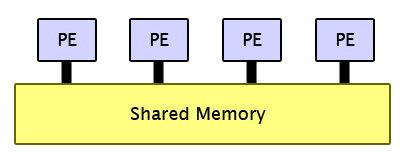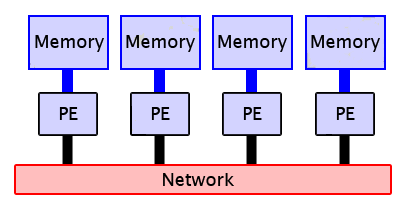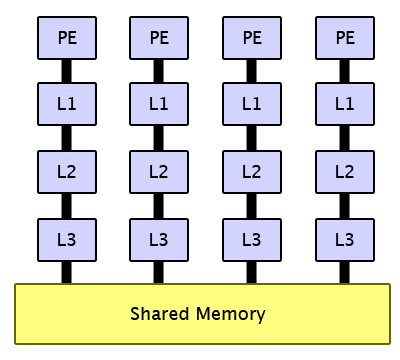|
Parallel Programming Paradigms - Processors and Memory
When writing a program for a computer it is important that the writer know
what the basic capabilities of the hardware are so that the writer
can make fundamental assumptions about its structure.
When writing code for parallel computers,
the writer must bear in mind a particular paradigm, or way of thinking,
regarding the structure of the hardware.
That paradigm implies basic assumptions about how fundamental hardware components, such
as processors and memory, are connected to one another.
These basic assumptions are crucial to writing
functionally correct and efficient parallel code.
We describe in this article the programming paradigm
used in modern parallel computing and how this paradigm came to be.
Its development is best understood both
in light of the architecture of the machines that run such codes and
in contrast other parallel computing paradigms, so these are also explored.
In order for people to write parallel applications and direct machines utilizing parallel computing with many processors,
the establishment of a flexible and fully capable way to program machines is essential.
We provide examples below to illustrate the issues involved when designing and running such codes.
|
|
|
What is Always True about Parallel Computing
By definition, parallel computing always involves multiple processors
(or computing elements or processing elements (PEs) or cores; below we use these terms interchangeably).
That's something on which all of its practitioners can agree.
Because we must derive parallel computers from today's incarnation of von Neumann-architected Turning machines,
the computer has memory, which is also agreed.
But the next question is: Where is the memory? How is it organized?
When there is only one processor, it is clear that the processor needs to access all its memory, but when
there are multiple, how should these processors be connected to memory?
Should the memory likewise be made "parallel" in some sense, or should the memory remain as one and homogeneous, as it was with one processor?
This is a fundamental question of parallel computer design because it has ultimately enormous, and potentially expensive, consequences
for hardware, software, and their designers and builders.
Parallel Computing of the 1990's - The Great Schism
Delineated by that very question, parallel computing paradigms of the 1990's falls into two major categories:
-
Shared Memory - Usually via threads, all processors can access all memory directly at any time
-
Distributed Memory - A processor can access only its own memory, but processors
can share data using message passing.
Access is the key, and, for processors, access means they are allowed to
read and write.
In a distributed memory system, a processor, in effect, "owns" its own memory. For such processors to
share data they must pass messages, much like how people make a phone call.
In contrast, processors on a shared memory system can easily read and write
the same location in memory in any order, like people being able to read, erase, and write on the same whiteboard.
While a leaving a message for the other processor is easy, resolving potential confusion is left to the program writer.
Problems whose parts are completely separated from and indepdent of one another
are trivial to parallelize.
For such problems running on shared or distributed memory matters little because the problem is already self-partitioned;
easy problems are easy to run in parallel.
But most interesting problems have some irreducible interaction between them.
The two different memory models or parallel computing paradigms
encourage two very different ways to handle interactions.
To illustrate the basic issue,
consider the following analogy: two people, Alice and Bob, working at a whiteboard.
The whiteboard corresponds to the shared memory and Alice and Bob are two
processors sharing that memory.
Suppose
Alice needs to add two numbers to produce the final answer. She can compute the first number, but the
second number is in fact a result from Bob.
Alice and Bob each require time to compute their numbers, so the idea is that Bob, once he has it,
will write his number on the second line of Alice's final summation.
Then when Alice has written the first number, she will sum her number with Bob's number and the calculation is complete.
Seems simple, right?
|


|
Maybe not. A great deal of uncertainty is how long Alice and Bob will take to compute their part of the problem.
Depending on the nature of the input, or the time of day, or if Bob or Alice get distracted, stop to take a drink, or other random or pseudorandom influences
Alice and Bob might complete their numbers at slightly different times.
Why is this important? We have three ways this photo finish could end up.
|
1. If we're lucky, Bob might finish first and write his answer on the second line before Alice writes
hers on the first line. Then Alice writes her number and sums it with Bob's and writes the correct answer.
So far so good.
|

|
|
2. But what if Alice was speedier than Bob? Then Alice writes her number first, and sums it with... nothing? Bob's number isn't there.
For the sake of
argument, suppose it was blank (in a computer that spot could contain random data).
So Alice sums her number with nothing, returning a different, wrong number. Then Bob
writes his number, but it has no influence on the output because it was not there in time.
The output simply is wrong.
|

|
|
3. We could have something in between happen. Since presumably Alice and Bob have equal ability to compute their numbers,
this scenario is likely because they might not finish at exactly the same second.
While Alice is halfway through writing her number, Bob begins writing his. Alice then can write
the sum of what she sees of her number and his, but it's a race: she will begin writing the sum of the two numbers
before Bob is finished writing his.
Because the data she used was incomplete, yet again the output is wrong.
|

|
Now, if Alice and Bob are human beings, they would not be this literal. Alice, if she's polite, would wait for Bob if she
was about to beat him to it. But the point is that, if these were processors A and B and the whiteboard is the
shared memory, they would in fact be completely literal
because they are just machines following instructions.
|
Then imagine if there were more than two numbers computed by as many others in the room.
Alice and Bob and Charlie and Dave and Edna and Fred and George and so on would each have a number
to write for Alice to sum together.
It would be chaos. The output, even if the given problem was the same, would be different every time!
If this were a computer, formerly the model of determinism and predictability, the machine would become completely unpredictable.
We cannot even depend on a programming error to give the same wrong answer every time.
If insanity is defined as expecting different results by doing the same thing,
then
we must be insane to program a machine that behaves this way.
|
|
|
In another example, to perform a Pascal's Triangle calculation with multiprocessing threads,
a similar problem can occur in a simplistic
shared memory solution.
Extending
the single-processor example,
each processor reads overwrites an element of the array,
one at a time,
with the sum of the original and its neighboring element.
The problem is that original values in memory
might get overwritten by another processor, resulting in a
wrong answer.
(Using a old duplicate copy of the problem space would double the memory requirements, which is not always possible.)
Without
properly organizing the data and communication
by partitioning the array and creating guard cells,
using a threads approach can give wrong answers and be confusing.
|

|
In the addition example,
the right thing to do is to explicitly manifest the dependency of Alice's final answer on Bob's completion of the second number.
There are (at least) two different ways to go about that.
Creators of typical shared memory implementations recognize that such machines are inherently nondeterminsitic, so
their solution is to have the software programmer
apply mechanisms to prune away this nondeterminism.
Specifically, the shared memory with threads approach would
it would use either a locking mechanism or a semaphore mechanism.
Locking means that a processor would specify that second line as locked, preventing Alice from computing the sum
until Bob unlocks it. Similarly, a semaphore means that Bob raises a flag to indicate to Alice to stop until Bob lowers the flag.
Either way, if Bob doesn't lock the second line of the sum or raise the semaphore in time, then Alice will output
a wrong answer again because it isn't there in time or is incomplete.
The above scenario, where Alice, Bob, Charlie, etc., are racing to write their numbers before Alice sums them is appropriately called
a "race condition".
This is a common problem when writing shared memory code.
In principle it can be solved with any of these methods, but the
additional issue with shared memory is that, when this condition occurs unforseen,
the output is random and not repeatable, so
diagnosing a problem when the symptom is never the same twice is very frustrating.
There could even be extenuating circumstances that causes the right answer to appear on one system,
but random answers to appear on another, further frustrating the writer.
Such shared memory issues are very difficult to isolate and solve.
Why was Shared Memory Invented?
|
Why indeed?
The reason is that, to the inexperienced,
adding a processor to a single-processor computer seems like a simple solution to getting more
computing power.
Hook up the second processor to the same memory bus, and the job is done, right?
As we can see by the above discussion, this becomes a difficult problem for the software writer.
But shared memory is a problem for the hardware designer too.
Modern processors have level 1, level 2, and level 3 (or more) memory caches (some of which are connected)
containing copies of pieces of main memory.
This fact exacerbated the problem of maintaining the illusion of a single, unified, homogeneous shared memory
accessible by all processors.
A processor might, in cache, have a piece of data that no longer exists in
main memory because it was just overwritten by another processor.
So the hardware must be enhanced to maintain what's called "cache coherency".
This problem, while arguably managable for two or four processors,
rapidly grows for eight or more.
Hardware becomes more complex and correspondingly expensive with the shared memory paradigm.
|

|
Distribute the Memory and Pass the Messages
|
The distributed memory with message passing approach is for Alice to wait for a phone call from Bob before attempting the sum.
In fact, extending this analogy for message passing, Bob is in an entirely different room with his own whiteboard; when he's ready, he makes the call, and
Alice, not Bob, writes the second line of the sum, so she knows his answer is ready, and she will
produce the right output every time with complete determinism. If Charlie or Dave or Edna try to call, they'll be on
call waiting until Alice has written Bob's answer, and she can take each of the other calls in order.
Again, the interdependency in this problem is clear and explicit, and
no one touches Alice's whiteboard but Alice.
|

|
As a practical matter, when a shared memory programmer wants to achieve the highest
levels of performance and reliability, what do they do?
They partition the memory and follow strict rules precisely when and where processors can
share data. That's essentially the distributed memory with message passing model.
Rather than emulate distributed memory with shared memory, perhaps it's simpler to just
start assuming the distributed memory paradigm in the first place.
What also works is a hybrid approach. Small multiprocessing machines (usually SMP) of two, or perhaps four,
processors each can be combined
in a network suitable for distributed memory message passing.
This solution takes advantage of multiprocessing within a box between just a few processors, but
uses message passing to share data between boxes.
In a sense, the multiprocessing approach becomes an orthogonal axis of parallelization from the
distributed-memory message-passing approach: messages are passed at the highest level of partitioning,
but multiple processors work within each node's partition.
It works because the multiprocessing count is not too high so the advantages of quickly sharing memory
can be used, yet message passing is applied to manage a large number of procesors.
Likewise the hardware expense is low because each node has only a few processors.
Software utilizing this approach is implemented in the
Power Fractal application, which adds yet a third
axis of parallelization with vector instructions.
It's Happened Before ...
The Great Schism of Parallel Computing in the 1990's centered around this debate between shared and distributed memory.
Proponents of shared memory would argue that writing code for such systems was easier than using distributed memory with message passing.
While for special examples the code would appear easier, but what these proponents do not seem to acknowledge is that
most of the interesting
problems have inherent dependency that cannot be eliminated.
The above examples introduce fundamental issues that occur when applying the shared memory paradigm to
such problems.
|
Silicon Graphics, Inc., (SGI)
became the primary corporate advocate of the shared memory approach.
While other companies like Intel, Cray, IBM, and Fujitsu abandoned shared memory in favor of distributed memory,
SGI, at their peak,
built impressive boxes with 256 processors all sharing memory at great expense.
SGI developed technologies that we know today as OpenMP and, because their approach worked well for
graphics because such applications are usually easy to parallelize, OpenGL.
But, when asked to build 1024 processor systems, even SGI would have to
build 4 nodes of 256 processors each connected via a network. Software and hardware layers would
recreate
the illusion of a shared memory system,
but its speed would at best be limited by the network,
just like for message passing.
While today distributed memory systems operate with several thousand processors,
SGI itself encountered a practical limit to the pure shared memory approach it advocated.
So by the 21st century, what was SGI's fate?
SGI was unable to produce technology sufficiently more powerful and more economic than its competitors in the HPC arena.
Likewise, the corporate fortunes of SGI faired poorly,
with stock prices under 50 cents per share after 2001,
sinking below NYSE minimums.
In 2006, SGI
filed for Chapter 11 bankruptcy and
major layoffs,
leaving its stock worthless.
Only in October does the company find new life
after a
complete financial overhaul.
|

|
In the meantime, clusters and supercomputers, well-represented at major supercomputing centers around the world,
adopted the MPI standard on distributed memory hardware. Today,
distributed memory MPI is the de facto
standard at the
San Diego Supercomputing Center,
National Center for Supercomputing Applications,
National Energy Research Scientific Computing Center,
Lawrence Livermore
National Laboratory and
many more. Consider the annual reports of any of these organizations where they hilight the
accomplishments they peform with their hardware.
Today it goes without saying that these applications use the MPI and distributed memory approach.
Even SGI's current product list
includes the distributed-memory message-passing
hardware design and MPI support.
|
... and It Will Happen Again
In 2004, the microprocessor manufacturers industry-wide encountered a wall in the form of
heat issues preventing
higher clock speeds, with Intel delaying,
then
cancelling a 4 GHz chip.
In 2005, Apple surprised the world when it decided to switch from PowerPC to Intel because it saw a growth path
in Intel processors that IBM chose not to pursue with PowerPC.
In 2006, Intel introduced their Core Duo processor, a chip that, as far as a software writer is concerned,
has two processors.
In addition, they announced that a four core chip is forthcoming and
rumor has it that both AMD and Intel are slating 8- and 16-core chips for 2007 and beyond.
Intel CEO Paul Otellini even previewed an 80-core chip as a way of pointing to a multicore future.
|

|
Where is this future?
Two insights come to mind.
First, Intel is advocating threads. By implication, what Intel is advocating essentially the shared memory approach
championed by SGI in the 1990's.
"Those who do not listen to history are doomed to repeat it."
Intel is following the path SGI has already tread,
only this time, because of Intel's microprocessor dominance,
the entire personal computer industry is following the path to doom blazed by SGI.
And we already know where SGI's old path ended: technological and financial ruin.
Does this make sense?
The End is Near
|
The second insight regards Moore's law.
The reign of the single-processor personal computer is over.
While Dr. Gordon Moore's original observation of doubling transistor count
every 18 to 24 months is holding true, by 2006 the popularized misinterpretation of
Moore's law regarding doubling performance per processor
is not.
Intel, as well as IBM, AMD, and others, could not produce faster processors because the chips ran too hot.
The fact that Intel saw it necessary to produce a chip with two Cores (as far as a software programmer is concerned
a Core is a processor) to increase total performance is very telling.
Essentially, Intel ran out of ideas to improve performance per chip save one: the technology of "copy and paste".
|

|
With the prospect of systems with four, eight, or more processors in a machine, it is left to the software programmers
to use these systems effectively.
Although industry is trending towards shared memory with threads, that is
a path the HPC industry has already shown
to be a mistake.
Instead, the reader can learn from scientists, particularly those scientists
who successfully apply massively parallel computing to major scientific problems,
that distributed memory with message passing is the most successful
approach to solve real-world problems using parallel computing.
The need for programming parallel computers has arrived at our desktops, and
lessons
learned from scientists who apply computing
can show us how if heeded.
For Additional Reading
|
Other tutorials on this web site show examples of code following these lessons.
Parallelization - a discussion about the issues encountered when parallelizing code
Parallel Zoology - compare and contrast parallel computing types: distributed, grid, and cluster computing and more
Parallel Knock - an exhibition of basic message-passing in a parallel code
Parallel Adder - an introduction to transforming a single-processor code with independent work into a parallel code
Parallel Pascal's Triangle - an introduction to parallelizing single-processor code requiring local communication
|

|
|
Parallel Circle Pi - an introduction to load-balancing independent work in a parallel code
Parallel Life - an introduction to parallelizing single-processor code running two-dimensional work
requiring bidirectional local communication
Visualizing Message Passing - a demonstration of message-passing visualization
and what it can teach about a running parallel code
You're welcome to read more about parallel computing
via the Tutorials page.
|

|
A number of other references also make for interesting reading:
Back to Top
|
















